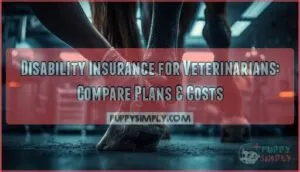This site is supported by our readers. We may earn a commission, at no cost to you, if you purchase through links.
A single kick from a fractious horse ended Dr. Sarah Chen’s surgical career at 34. She’d spent eight years building her specialty practice, but her shattered wrist never regained the fine motor control surgery demands. Without disability insurance for veterinarians, she would have lost everything—her income, her student loan payments, her home. Instead, her own-occupation policy paid 60% of her surgical income while she transitioned to consulting work.
The veterinary profession ranks second only to dentistry for occupational injuries, yet many vets practice without income protection. Between animal bites, zoonotic diseases, repetitive strain injuries, and the physical demands of restraining large animals, your hands and body face daily risks that could sideline your career tomorrow.
Most disability policies cost less than your monthly student loan payment but replace decades of lost income if injury or illness forces you out of practice.
Table Of Contents
- Key Takeaways
- Why Veterinarians Need Disability Insurance
- Types of Disability Insurance for Veterinarians
- Key Features to Consider in a Policy
- Comparing Disability Insurance Providers
- Cost of Disability Insurance for Veterinarians
- How Much Coverage Do Veterinarians Need?
- How to Obtain Disability Insurance
- Trends in Disability Insurance Adoption
- Frequently Asked Questions (FAQs)
- What are the tax implications of disability insurance benefits for veterinarians?
- What are the potential consequences for veterinarians who do not have disability insurance?
- Can veterinarians get disability coverage while still in school?
- What happens to coverage if I change veterinary specialties?
- Can I purchase coverage if I work part-time or locum?
- Conclusion
Key Takeaways
- Veterinarians face the second-highest injury rate among health professionals—10.2 cases per 100 workers in 2022—making disability insurance essential protection against daily occupational hazards like animal bites, kicks, and zoonotic diseases.
- Own-occupation policies are critical for vets because they pay full benefits if you can’t perform your specific veterinary duties, even if you work elsewhere, yet only 40% of veterinarians carry individual coverage despite 93% recognizing the need.
- Most disability insurance for veterinarians costs between $99 and $298 monthly and replaces up to 60% of income, with policies purchased before age 40 saving up to 25% compared to waiting until later in your career.
- Student loan riders can dedicate up to $2,500 monthly toward debt repayment during disability—a vital feature when average veterinary student debt exceeds $150,000 and monthly payments typically run $1,800.
Why Veterinarians Need Disability Insurance
Your veterinary degree took years to earn, but a single injury or illness could put your income at risk faster than you think. The profession comes with unique hazards that make disability insurance more than just a safety net—it’s essential protection for your financial future.
Here’s what you need to understand about the risks you face and why coverage matters.
Occupational Injury and Illness Risks
Among health professionals, you face the second-highest injury rate—10.2 cases per 100 workers in 2022, quadruple the national average. Animal bites, kicks, needlestick injuries, and zoonotic exposure create daily risks.
Veterinarians face the second-highest injury rate among health professionals—10.2 cases per 100 workers, quadruple the national average
Injury under-reporting remains common, masking the true financial impact. A recent study highlights that injuries are normalized within the veterinary profession.
Without strong safety culture and prevention strategies, these incidents can sideline your career. That’s where disability insurance and medical expense coverage become essential safeguards.
Income Protection for Veterinary Professionals
Your income is your most valuable asset, and protecting it isn’t optional. Most disability policies replace up to 60% of your earnings—but that’s gross income. Here’s what you need to know:
- Average monthly benefit is $1,223 from Social Security
- Employer plans cap benefits at $6,000-$9,000 monthly
- 69% of general practitioners are primary earners
- Taxable employer benefits reduce your actual payout
- Private policies offer untaxed income replacement
Financial security depends on benefit adequacy that matches your lifestyle and obligations. Veterinarians, facing unique occupational hazards, should consider how disability insurance protects their income.
Impact on Career and Lifestyle
Beyond income protection, disability coverage shapes your entire veterinary career trajectory. Without it, 60% of career vulnerability stems from just 40% of vets holding private policies.
Mental wellbeing suffers—41% report burnout post-claim. Family stability hinges on coverage: 78% maintain mortgages versus 45% without.
Professional growth continues when 32% retrain during absence. Financial planning protects living expenses and your future.
Types of Disability Insurance for Veterinarians
Not all disability insurance works the same way. Some policies cover you for a few months while you recover from a broken arm, while others protect your income for years if you can’t practice veterinary medicine anymore.
Let’s look at the main types you’ll encounter when shopping for coverage.
Short-Term Vs. Long-Term Disability
When comparing short-term disability insurance and long-term disability insurance, consider two key issues: how soon you need help and how long you’ll need it. Short-term policies typically kick in quickly—often within zero to 30 days—and provide coverage for 13 to 52 weeks. They are ideal for temporary setbacks such as minor injuries or pregnancy.
Long-term coverage, on the other hand, has waiting periods of around 90 days but can protect your income for decades, even until retirement.
Cost comparison is also important: short-term insurance runs about $0.08 per hour worked, while long-term coverage costs approximately $0.05 per hour through employer plans, making extended protection surprisingly affordable.
Own-Occupation Policies
If you can’t perform your specific veterinary duties, a true own-occupation policy pays full benefits—even if you work elsewhere. That’s what sets it apart from modified or any-occupation policies, which may cut or stop payments if you take another job.
About 93% of veterinarians recognize the need for this coverage, yet only 40% carry an individual own-occupation policy. These policies generally replace 60% to 70% of your income, with monthly benefit caps around $12,500. Policy riders like cost-of-living adjustments and future purchase options let you customize coverage as your career grows.
Key Features to Consider in a Policy
When you’re shopping for disability insurance, the fine print matters more than you might think. The right policy features can make the difference between real financial protection and a policy that falls short when you need it most.
Let’s break down the key elements you should look for before signing on the dotted line.
Elimination and Benefit Periods
Two key decisions shape your disability insurance for veterinarians: the elimination period (waiting period before disability benefits start) and benefit duration. Most vets choose a 90-day elimination period to balance premium impact with financial planning needs. For benefit period options, 78% select coverage until age 65.
Longer elimination periods lower costs but require stronger emergency funds. Policy customization around these features directly affects your wallet and protection.
Definition of Disability
Your policy’s disability definition determines when disability benefits kick in. Own-occupation policies protect veterinarians who can’t perform their specific duties—even if they work elsewhere. Any-occupation coverage only pays if you can’t do any job matching your background. Most vets secure own-occupation or regular occupation definitions.
Partial disability covers income loss from reduced hours, while mental health provisions cover stress and burnout—critical given rising claims.
Policy Riders and Customization Options
Riders let you build customized coverage that grows with your career. The future increase option boosts your monthly benefit without new medical exams—essential as income climbs. Student loan riders dedicate up to $2,500 monthly toward debt. COLA adjustments protect against inflation, while residual benefits cover partial disability.
Each rider impacts premiums differently, so weigh benefits against costs. Spouse/Domestic Partner Coverage can extend protection to loved ones.
Comparing Disability Insurance Providers
Not all disability insurance providers are created equal, and knowing where to look can save you time and money. Some carriers specialize in veterinary professionals, while others offer broader commercial policies with competitive rates.
Let’s compare the key players based on their offerings, member benefits, and financial reliability.
AVMA LIFE and Member Benefits
AVMA membership unlocks Insurance and risk solutions designed for your practice through the AVMA LIFE Trust. Their Basic Protection Package bundles disability, life, and accident coverage for under $5 monthly.
You’ll find Veterinary professional insurance with Coverage Amounts reaching $12,500 monthly for long-term disability—capped at 60% of earnings. Policy Riders like Future Purchase Options let benefits grow with income. Benefit Periods extend to age 70, while Membership Integration with Pearl Insurance ensures easy Insurance coverage options ahead.
Leading Commercial Insurers
Beyond AVMA, five major providers dominate the market share for veterinary disability insurance: Massachusetts Mutual, Ameritas, Guardian, Principal, and The Standard. Each carrier brings distinct policy features—Guardian extends benefit periods to age 70, while Principal offers up to $30,000 monthly benefits.
Customization options include student loan riders and inflation protection. Their application process ranges from traditional underwriting to guaranteed-issue group coverage, giving you flexibility to match your practice needs.
Financial Strength and Ratings
An insurer’s A.M. Best or S&P rating reveals its claims payment ability when you need income protection most. Guardian and MassMutual both hold AA+ ratings, while Ameritas maintains A+ status—strong signals of long-term security.
Check each carrier’s Comdex score for a composite view of financial security.
State guaranty funds provide backup protection if an insurer fails, though coverage caps vary by state.
Cost of Disability Insurance for Veterinarians
Understanding what you’ll pay for disability insurance helps you plan ahead and protect your income without breaking the bank. Most veterinarians pay between $99 and $298 per month, but your actual cost depends on several factors unique to your situation.
Let’s break down what influences your premium, what typical coverage costs, and how to adjust your policy to fit your budget.
Average Premium Ranges
Most veterinarians pay between $106 and $298 monthly for disability insurance, though annual billing can reduce your costs slightly. Gender differences matter—female veterinarians often face higher premium rates than males for identical coverage.
Regional variations and group discounts through your practice or AVMA membership can lower these figures.
Policy riders add $20–$50 monthly, while level rates help you lock in predictable long-term costs.
Factors Affecting Premiums
Your premiums depend on more than just coverage amount. Here’s what shapes your cost of disability insurance:
- Age – Rates climb 8% per decade after 30, with policies secured before 40 saving you up to 25%
- Gender – Female veterinarians face roughly 25% higher insurance premium rates due to claim patterns
- Health – Chronic conditions or smoking can spike costs 20–35%
- Occupation – Large animal specialists pay up to 45% more than small animal vets
Disability insurance riders and level rates add flexibility but increase monthly bills $20–50.
Customizing Coverage to Fit Budget
The good news? You can trim your disability insurance coverage costs without sacrificing protection. Shortening your benefit periods or stretching elimination options to 180 days can slash premiums by 40%.
Skip optional policy riders you don’t need now—you can add them later as your practice grows.
Premium strategies like multi-policy discounts offer another route to affordable career adaptation.
How Much Coverage Do Veterinarians Need?
Figuring out how much disability coverage you need isn’t about picking a random number—it’s about protecting what you’ve worked hard to build.
Most veterinarians need enough coverage to replace their income, cover ongoing expenses, and handle financial obligations like student loans.
Let’s break down the three main factors that determine your ideal coverage amount.
Calculating Income Replacement Needs
Your coverage needs start with a simple expense assessment: add up monthly living expenses, loan protection requirements, and dependent costs. Most disability income insurance policies replace up to 60% of your gross income through monthly benefits.
Factor in your student loan payments—averaging $1,800 monthly—and benefit periods that align with your timeline to financial independence.
Policy riders and income protection features let you customize income replacement to match your actual needs.
Supplemental Policy Options
Beyond base own-occupation policy limits, you can increase protection through riders and group coverage. Partial riders compensate for reduced income if you’re working limited hours—about 60% of policies include this option. Future increase options let you boost coverage as earnings grow, no new underwriting required.
Catastrophic coverage adds monthly benefits if daily activities become impossible. Renewable riders lock in your terms and premiums for life.
Student Loan Protection Considerations
If student debt exceeds $150,000, specialized loan riders deserve serious attention. Standard disability insurance covers income replacement, but monthly payments averaging $1,808 won’t pause if you can’t work. Loan riders target this gap directly.
Federal TPD discharge exists, though approval takes months. IDR impacts under reduced earnings help, yet VMLRP effects complicate planning—program participation ends with disability. Repayment options through insurance beat default risk every time.
How to Obtain Disability Insurance
Getting disability insurance doesn’t have to feel like finding your way through a maze. The process is more straightforward than you might think, especially with options designed specifically for veterinarians.
Let’s walk through what you need to know about eligibility, simplified underwriting, and finding the right coverage at the best price.
Eligibility and Application Process
Most insurers require you to work at least 30 hours weekly and prove your current income for eligibility. The underwriting process includes:
- Application Documentation – Submit tax returns, pay stubs, and detailed job descriptions
- Medical Underwriting – Complete health questions, possibly a medical exam and lab screenings
- Approval Timelines – Expect 4–8 weeks for individual policies; group coverage may approve faster
Incomplete forms or chronic conditions create common eligibility barriers.
No Medical Exam Policies
If you’re pressed for time, no medical exam policies skip invasive health tests and speed up approval—often within days instead of weeks. These plans simplify the underwriting process, making insurance coverage accessible even with pre-existing conditions.
However, group options generally cap coverage limits at $5,000 to $6,500 monthly, and premiums may run slightly higher per dollar of protection due to increased insurer risk.
Tips for Comparing Quotes
Think of comparing quotes like shopping for a used truck—you wouldn’t buy the first one you see. Independent brokers deliver five-plus quotes in one inquiry, revealing how premiums shift with rider selection and coverage options.
Association discounts through groups like AVMA can slash premium rates 10-30%.
With policy standardization lagging—only 39% of carriers use identical definitions—scrutinizing insurance policy features protects your disability coverage investment.
Trends in Disability Insurance Adoption
The disability insurance landscape for veterinarians is changing as practices evolve and awareness grows. More vets are customizing their coverage to match the unique risks they face in modern clinics.
Let’s look at two key trends shaping how veterinarians approach disability protection today.
Customization for Modern Veterinary Practices
Modern disability insurance policies now bend to fit your unique practice, not the other way around. Modular policies let you select specific benefit and elimination periods—over 80% of insurers offer this flexibility. You’ll find coverage options that adapt as your career evolves:
- Practice-specific customization includes residual disability coverage in 83% of plans, protecting you if you can only work reduced hours.
- Specialized riders like student loan repayment (covering up to $2,500 monthly) address your actual financial pressures.
- Digital integration in 65% of new offerings streamlines claims and policy management online.
Transferability and growth potential make sure your coverage grows with you.
Growing Demand and Awareness
You’re seeing awareness and adoption shift in real time. Today, 93% of veterinarians recognize the need for disability income insurance, yet only 40% actually carry individual coverage. That gap matters when 69% to 86% of veterinarians serve as primary income earners in their households.
Social Security averages just $1,222.75 monthly—barely enough to cover basics. Growing pet ownership across 90 million U.S. households means more demand for your services and greater exposure to injury.
Financial protection isn’t optional when student debt averages $150,000 and workplace hazards remain constant.
Frequently Asked Questions (FAQs)
What are the tax implications of disability insurance benefits for veterinarians?
The tax implications of disability insurance benefits hinge entirely on one factor: who paid the premiums.
If you covered premiums with after-tax dollars, your benefits arrive tax-free—no income replacement lost to Uncle Sam.
What are the potential consequences for veterinarians who do not have disability insurance?
Without disability insurance, you risk financial ruin and bankruptcy from lost income. Career setbacks, mounting debt, and lifestyle downgrade often follow.
Mental health suffers under stress, while savings vanish without income replacement or financial protection.
Can veterinarians get disability coverage while still in school?
You’ll face risks before you ever earn your first paycheck. Full-time veterinary students can enroll in disability income insurance through programs like AVMA VetSTEPP, often without medical exams during open enrollment.
What happens to coverage if I change veterinary specialties?
Most individual policies remain valid when you switch specialties, but you’ll need to notify your insurer within 30 days. They may adjust your premiums and benefits based on the new specialty’s risk profile.
Can I purchase coverage if I work part-time or locum?
Yes, you can secure coverage working part-time or locum, though you’ll need to meet minimum weekly hours—usually 18 to 24—and provide income documentation.
Individual policies offer better options than group plans for non-full-time benefits.
Conclusion
Don’t let your career rest on a wing and a prayer when one bite, kick, or slip could change everything. Disability insurance for veterinarians protects the income you’ve worked years to build—usually for less than your monthly loan payment.
Whether you choose own-occupation coverage through AVMA LIFE or a commercial carrier, the right policy ensures one bad day doesn’t derail decades of dedication to animal care.
Compare quotes now, before you need the coverage.
- https://www.mgis.com/blog/disability-insurance-for-veterinarians/
- https://www.studentloanplanner.com/disability-insurance-veterinarians/
- https://www.piu.org/personal-disability-insurance/veterinarians
- https://www.policygenius.com/disability-insurance/veterinarians/
- https://www.veterinary-practice.com/article/does-our-profession-have-a-problem-with-disability
















